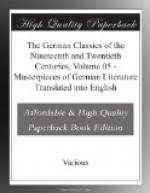As the earlier men centred in Jena, so the later Romanticists flourished in Heidelberg, that city which Eichendorff called “itself a magnificent Romanticism.” The earlier group was largely North German and brought with it clear perception and a certain power of analysis, an ability to dissect and to reason. With the Heidelberg group the South begins to play a larger part, though there were a number of North Germans in it. The richer fancy, the longer literary tradition, now add color to their productions. It is significant, too, that though “castle Romanticism” does not die out, a new note is struck with the celebration of the Rhine in song, story, and legend. The river begins with Romantic tradition and in a Romantic milieu, but rises to political significance as “Germany’s stream and not Germany’s boundary.” The southward tendency of the movement reached its climax when its centre shifted to Munich, with a culture-loving king, an Academy of Sciences and a new University. Munich was fortunately not destined to become like Vienna, that other South German city, “a Capua of the spirit.”
Though certain members of the later Romantic group were closely associated with each other in a way that was unknown to the older set, Arnim and Savigny having each married a sister of Brentano, there was less real solidarity among them than in their forerunners. By no means all the men treated within the confines of the present article had the close personal association which, when combined with intellectual or literary activity, goes by the rather loose name of a “school.” The first Romanticists were held together by a common effort to formulate or to attain a speculative philosophy. In the second group, there was a decentralizing, catholicizing tendency, and, above all, a greater individual creative ability. It was not merely the chance difference of external fortunes that kept them apart, though they never held together after the death of Brentano’s wife in 1806, but that each projected his individuality into his literary work rather than into a common polemic ideal. The path-finding and discovery had already been done; in the quieter backwater it was possible to develop well-rounded works of real esthetic value.
Very significant of the differences between the schools is their journalistic activity. The ideal of the first Romanticists was to work without collaboration; but the very prospectus of Arnim’s Journal for Hermits is signed by a company of editors. The early journals were turned to the study of German literature through a renunciation of the present; the later Germanic studies arose from a high idealism and from a sincere desire to awaken the present to new national activity. When, later in life, Goerres remarked of these journals that their collaborators felt as if they were accompanying the Holy Roman Empire to its grave, he was thinking of the year in which the most important of them flourished, 1808. In this, Germany’s darkest period, Kleist’s Phoebus, so cordially hated by many, and Arnim’s Journal for Hermits had their brief but influential career.




